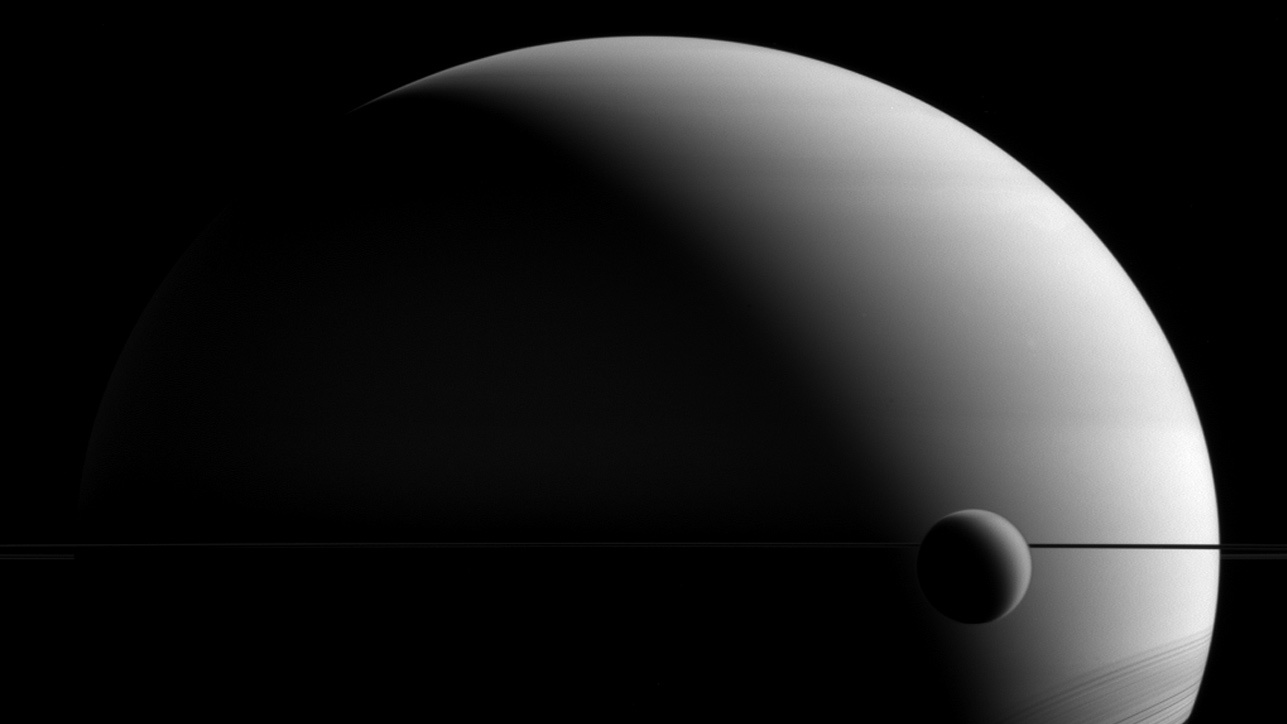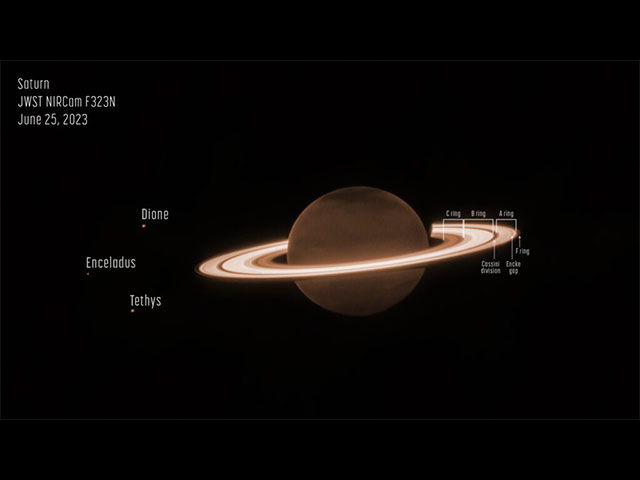Introduction
This page showcases our resources for those interested in learning more about Saturn and Titan. It includes activities that can be done at home as well as videos, animations, stories, and articles.
HighlightsHighlights
Videos & Animations
-
Since their discovery by NASA's Voyager Mission in the 1980s, temporary "spoke" features across Saturn's rings have fascinated scientists, yet eluded explanation. Learn more about these features in this video.
-
Learn about how Saturn’s moon, Titan, is expanding our understanding of the chemical complexity of the solar system and the potential for life in the universe.
-
Earth is not the only place in the solar system with rain, rivers, lakes, and seas. Saturn’s moon Titan has them, too – not of water, but of liquid methane and ethane. This Earth-like world even hides an ocean of liquid water deep beneath its surface! Find out what you need to know about Titan.
DRAGONFLY
-
In May 2022, engineers from the Johns Hopkins Applied Physics Laboratory returned to Imperial Dunes, California, to send a test model of Dragonfly through the skies to collect additional data that will help them develop guidance, control, and navigation algorithms for the actual Dragonfly spacecraft.
-
Learn about the Dragonfly mission to Titan: how we’ll get there, what we’ll do there, and how it could teach us about the building blocks of life, in this video.
-
Before the actual Dragonfly soars over the organic dunes of Titan, discover how the team developing the NASA rotorcraft lander at the Johns Hopkins Applied Physics Laboratory is testing the concept by sending instrumented models over the sands of Earth’s deserts.
-
Dragonfly is a NASA mission to explore the chemistry and habitability of Saturn’s largest moon, Titan. Dragonfly will send an autonomously operated rotorcraft to visit dozens of sites on Titan, investigating the moon’s surface and shallow subsurface for organic molecules and possible biosignatures. Explore these animations to learn more about Dragonfly and its various instruments.
-
Discover how Dragonfly’s suite of science instruments will investigate the chemistry and habitability of Titan.
-
Experience Dragonfly, NASA’s revolutionary new mission to Titan, in this video trailer.
-
Search this gallery for videos, animations, images, and illustrations of the Dragonfly mission to Titan.
CASSINI
-
Learn how the Cassini spacecraft used its Composite Infrared Spectrometer (CIRS) instrument to study Saturn and its moons in heat radiation.
-
Discover some of the last images that the Cassini spacecraft took during its Grand Finale in 2017, completing a 13 year long exploration of Saturn and its moons.
-
Explore Saturn’s north-polar region which features a prominent hexagon-shaped polar vortex.
-
Learn about the end of the Cassini mission to Saturn from one of the key strategic planners of the Grand Finale portion of the mission.
-
Discover how the Cassini mission revolutionized our understanding of Saturn, its complex rings, its assortment of moons, and its dynamic magnetic environment.
Activities
-
Exploring the Universe: Ice Orbs
Learn how NASA planetary scientists are probing ocean worlds in the outer solar system, searching for evidence of liquid water and possible signs of life beneath the icy surface. Put what you learn into practice by investigating a frozen sphere using various tools to learn about objects hidden inside.
This activity can be adapted to include other tools and probes, whatever you may already have on-hand.
Note: This activity is also available in Spanish.
-
3D Models
Stories
10 Things: Unsolved Mysteries of Saturn’s Moons
Saturn boasts a collection of 62 exotic moons, and while we’ve learned some amazing things about these moons, there are many open questions about them and what they can teach us about the evolution of the solar system. This article describes just ten of the many mysteries that scientists are currently working to solve.
Titan and Astrobiology
Did you know that Titan, one of Saturn’s moons, is considered to be an “ocean world” and that it has the potential to harbor life?
Titan is believed to have a salty subsurface ocean – as salty as the Dead Sea on Earth – beginning about 30 miles (50 kilometers) below its ice shell. It is possible that Titan’s ocean is thin and sandwiched between layers of ice or that it is thick and extends all the way down to the moon’s rocky interior.
Titan is expanding our understanding of the chemical complexity of the solar system and the potential for life in the universe. The Dragonfly mission (a rover-size drone-like vehicle) will take advantage of the moon’s environment (thick atmosphere and low surface gravity) to sample materials and determine the surface composition in dozens of locations across the icy world. Dragonfly is scheduled to launch in June of 2027 and arrive at Titan by 2034.
Articles
-
Dragonfly, a new NASA mission to Saturn’s giant moon Titan, will carry an instrument called the Dragonfly Mass Spectrometer (DraMS), designed to help scientists hone in on the chemistry at work on Titan. It may also shed light on the kinds of chemical steps that occurred on Earth that ultimately led to the formation of life, called prebiotic chemistry.
-
Before it can fly its revolutionary rotorcraft over the organic dunes of Saturn’s moon Titan, NASA’s Dragonfly mission team needs to navigate a series of independent reviews to demonstrate the flight project is on track.
-
At the Space Laser Assembly Cleanroom (SLAC) at NASA’s Goddard Space Flight Center, the Laser and Electro-Optics Branch is building a laser for NASA’s Dragonfly mission to Titan. Scientists will use this laser to detect what Titan’s surface materials are made of.
-
Advancing our search for the building blocks of life, the Dragonfly mission will fly multiple sorties to sample and examine sites around Saturn’s icy moon, Titan.
-
Discover how research on nine craters on Titan has provided more details about how weathering affects the evolution of the moon’s surface – and what lies beneath.
-
Learn why NASA is preparing to send the drone-like spacecraft Dragonfly to delve deeper into Titan, a world that has become one of the most important targets of solar system exploration.
-
NASA scientists identified a molecule in Titan’s atmosphere that has never been detected in any other atmosphere. In fact, many chemists have probably barely heard of it or know how to pronounce it: cyclopropenylidene, or C3H2. Scientists say that this simple carbon-based molecule may be a precursor to more complex compounds that could form or feed possible life on Titan.
Other Resources
-
Check out this blog from NASA’s James Webb Space Telescope that highlights Webb’s first near-infrared observations of Saturn, and the science we are learning from them.
-
NASA’s Solar System Poster Series
Download and print the Saturn-related installments of NASA’s solar system poster series.
-
Search this gallery for a variety of Cassini-related videos, images, graphics, and posters.
-
A 3D environment full of real NASA mission data. Hop on an asteroid, fly with NASA spacecraft, see the entire solar system moving in real-time, and more. You control space and time.
-
NASA’s Solar System Treks
The Solar System Treks are online, browser-based portals that allow you to visualize, explore, and analyze the surfaces of other worlds using real data returned from a growing fleet of spacecraft. You can view the worlds through the eyes of many different instruments, pilot real-time 3D flyovers above mountains and into craters, and conduct measurements of surface features.
-
This NASA e-Book celebrates Saturn as seen through the eyes of the Cassini spacecraft.
NASA JPL Photojournal Highlights
-
Saturn’s fourth-largest moon, Dione, can be seen through the haze of the planet’s largest moon, Titan, in this view of the two posing before the planet and its rings from NASA’s Cassini spacecraft.
-
Saturn’s moon Enceladus drifts before the rings and the tiny moon Pandora in this view that NASA’s Cassini spacecraft captured on Nov. 1, 2009.
-
Saturn’s rings are shown casting shadows on the planet.
-
A comparison of one of the first images from Cassini to one of its last.
-
A view of Saturn’s most prominent feature, its dazzling ring system.
-
Earth as seen from Cassini’s view at Saturn.
-
A look at the surface of Titan, one of Saturn’s moons.





